| |
Erroneous
Use of Unleavened Bread
(azymes or matzah) in the Eucharist |
|
The
Lord's supper was not the Passover meal!!
The main reason
that the Latins give for using unleavened bread in the Eucharist is
the totally false assumption that Joshua used unleavened bread at the
Last Supper.
The Last Supper
was held on the night of Tuesday/Wednesday—the day before
the Passover—and before the Feast of Unleavened Bread
. . . which began on the following day.
The Roman method
of reckoning time (which we use today) began from midnight to midnight;
and the Jewish 24 hour day actually began in the evening at 6:00 p.m:
And Elohim saw
every thing that he had made, and, behold, it was very good. And the
evening and the morning were the sixth day. (Genesis
1:6).
In the famous painting
entitled The Last Supper by Leonardo da Vinci we see bread and wine....
It looks like ordinary bread which Joshua took and blessed but it is
impossible to tell from the painting:
And he took bread
(Gk. artos), and gave thanks, and brake it, and gave unto them, saying,
This is my body which is given for you: this do in remembrance of
me. (Luke 22:19).
The word that Joshua
used for bread (artos) occurs about 65 times in the New Covenant, and
it always refers to regular bread made with yeast or leaven.
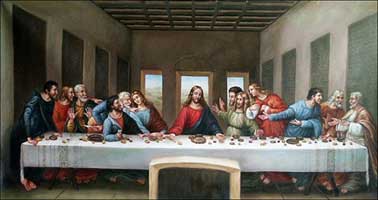
The Last Supper by Leonardo da Vinci. |
Joshua
had a leisurely Last Supper of bread and wine with his disciples
and washed their feet. |
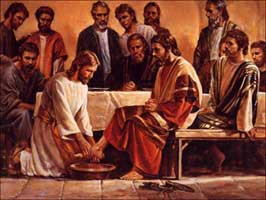
Joshua washing the disciples' feet. |
The Last Supper
had nothing in common with the Passover.
In this painting,
we do not see any roast lamb on the table, which was a requirement for
the Passover supper.
Joshua had a leisurely
meal with his disciples, which lasted for several hours, as He gave
them final instructions before His death....He was reclining
at table which was absolutely forbidden for the Passover meal:
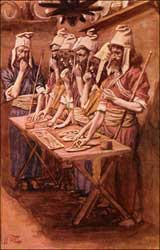
Depiction of Passover
by French artist James Tissot.
|
"And
thus shall ye eat it; with your loins girded, your shoes on
your feet, and your staff in your hand; and ye shall eat it
in haste: it is the LORD's passover."
(Exodus 12:11).
The
Khazars celebrate "Passover" with a meal like
the Last Supper, but it has nothing in common with
the annual Jewish Passover celebration as commanded by JEHOVAH
in the Torah.
|
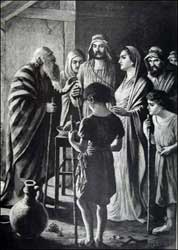
Artistic
depiction of the Passover celebration.
|
The Passover meal
was eaten STANDING and in haste to signify the quick flight from Egypt.
The only items on the menu were roast lamb, unleavened bread, and bitter
herbs with no wine mentioned.
Unleavened
bread was used by the Latins for the first 1000 years!!
Leavened
or common bread made with yeast or leaven was used by the Latin church
for the first 1000 years of Christianity.
The
Latins changed the form while the Orthodox still follow the Apostolic
pattern.
Here
is a quote from a Latin priest and professor of theology at the university
of Vienna named Johannes H. Emminghaus:
In
the Latin Rite, the bread for the Eucharist has been unleavened since
the eighth century; that is, it is baked of flour and water without
yeast. At the Last Supper, Christ probably took this kind of bread
(mazzah), which was interpreted in the Passover memorial as a "bread
of affliction," the bread of nomadic shepherds who had no homeland
of their own. During the first millennium of
Church history, however, it was the general custom in both East and
West to use normal "daily bread," that is, leavened bread,
for the Eucharist; the Eastern Churches still use it and usually have
strict prohibitions against the use of unleavened bread (or "azymes").
The Latin Church, for its part, regards the question as of little
importance, since at the Council of Florence, which sought to reunite
East and West (1439), the difference in custom was simply acknowledged
and accepted. (Rev. Johannes H. Emminghaus, The Eucharist: Essence,
Form, Celebration, p. 161).
Here is a quote from
a Jesuit priest and professor of Theology at the University of Innsbruck:
In
the West, various ordinances appeared from the ninth century on, all
demanding the exclusive use of unleavened bread for the Eucharist.
A growing solicitude for the Blessed Sacrament and a desire to employonly
the best and whitest bread, along with various scriptural considerations—all
favored this development. Still, the new custom
did not come into exclusive vogue until the middle of the eleventh
century. Particularly in Rome it was not universally accepted till
after the general infiltration of various usages from the North.
In the Orient there were few objections to this usage during olden
times. Not till the discussions that led to the schism of 1054 did
it become one of the chief objections against the Latins. At the Council
of Florence (1439), however, it was definitely established that the
Sacrament could be confected in azymo sive fermentato pane.
Therefore, as we well know, the various groups of Orientals who are
united with Rome continue to use the type of bread traditional among
them. (Rev. Joseph A. Jungmann, SJ., The Mass of the Roman Rite,
vol. II, p. 34).
In
other words, the use of unleavened bread with the round host came from
the forests of Germany.
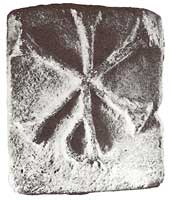
Eucharistic
bread stamp.
|
Eucharistic
bread stamps were found in Germany dating back to the 5th and
6th centuries after Christ.
These stamps
were used in baking ordinary every day leavened bread that was
used for the Eucharist.
|
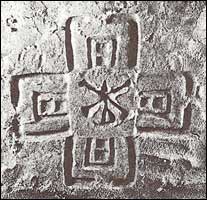
Regular
bread used in the Eucharist.
|
Here is a quote
from the book Bread and Liturgy by George Galavaris:
The
same baking method and ovens were used by the Christians for both
their daily bread and that which was to be used in worship. It must
be made clear that (contrary to practices today in the West) in
the Early Christian centuries and in all eastern rites through the
ages, except in the Armenian church, the bread used for the Church
did not differ from ordinary bread in substance. From the beginning
leavened bread was used. Even the Armenians before the seventh century
and the Maronites before their union with Rome in the twelfth century
used leavened bread. The practice of using unleavened bread for
the Eucharist was introduced to the West much later. Among the earliest
written accounts is that given by Alcuin (A.D. 798) and his disciple
Rabanus Maurus. After this the altar bread took the light, wafer
like form, achieved with pressing irons, so common today. (Galavaris,
Bread and Liturgy, p. 54).
The Latin Vulgate and
unleavened bread prepared the way for the mass or transubstantiation.
The
Vulgate prepared the way for TRANSUBSTANTIATION!!
Here
is the dictionary definition of TRANSUBSTANTIATION:
| 1. |
Conversion
of one substance into another. |
| 2. |
Theology.
The doctrine holding that the bread and wine of the Eucharist are
transformed into the body and blood of Jesus, although their appearances
remain the same. |
The
Latin Vulgate and unleavened bread prepared the way for the
monstrous doctrine of TRANSUBSTANTIATION. In the Sermon on the Mount,
Joshua told his disciples to pray for their daily bread:
Give
us this day our daily bread. (Matthew 6:11).
On
the other hand, the Latin Vulgate tells us to pray for our supersubstantial
bread:
Give
us this day our supersubstantial (Lat.supersubstantialem)
bread. (Latin Vulgate Version).
This
doctrine teaches that the communion bread actually becomes the body
and blood of Christ . . . and is to be worshipped as God.
Ordinary
bread would not do for this stupendous "miracle" so special
bread was required. The bread which was formally baked by the laity
now required special preparation by the monks or priests.
This
teaching was first promulgated in 831 by a French monk named Paschasius
Radbertus (785-865) who wrote a book entitled De Corpore et Sanguine
Domini. Naturally, it caused a firestorm of opposition and one
of its main opponents was an Hibernian (Irish) missionary named John
Scotus Erigena:
The
year 831 is a memorable one in the annals of ecclesiological development.
In that year an enormity, which four hundred years after came to bear
the barbarous name of transubstantiation, had its first conception
in the human mind. In 831 it appeared in the book of Paschasius Radbertus,
a French monk, in which for the first time it was propounded to the
world that the body of Christ in the sacrament is the very same which
was born of the Virgin, and was nailed to the cross. The whole Western
Church was astounded. The greatest theologians of the age declared
the notion to be absolutely new, and offered it their most strenuous
opposition. Nowhere was the repudiation of this stupendous novelty
more emphatic than in the Scottish Church and her allied branches.
In the front rank of its opponents were the Scoto-Irish divines, among
whom was Johannis Scotus, Erigena, the founder of the University of
Paris. Scotus was then residing at the Court of Charles the Bald of
France, and that monarch called upon him to enter the lists against
Paschasius. The great Culdee scholar responded to the royal call,
and wrote a book in condemnation of the revolting dogma, for so did
the French Church of that age regard it. Another distinguished divine,
Bertram by name, took part with Scotus in his war against the new
and monstrous proposition. The book of Bertram, written in refutation
of Paschasius, is still extant, and occupies a distinguished place
with the Bible in the Index Expurgatorius of Rome. The work of Johannis
Scotus had ultimately a different though a not less honourable fate.
About two hundred years after, when the doctrine of transubstantiation,
strengthening as the darkness deepened, began to make way in Germany
and France, Berengarius stood forth as its uncompromising opponent.
To maintain himself in the storm of persecution which is bold defence
of the truth drew upon him, he appealed to the work of Scotus, as
showing that his own views of the sacrament were those of the Church
of the ninth century. This drew the tempest upon the book of Scotus
without diverting it from Berengarius. The work of our countryman
had the honour of being committed to the flames by order of Pope Leo
IX., A.D. 1050. But this title has been preserved in the records of
the age, and remains to this day to witness to the orthodoxy of the
Scoto-Irish Church, and of the Church universal, on the head of the
sacrament, till towards the opening of the tenth century. That title
runs thus: "The Sacraments of the Altar are not the real Body
and Blood of Christ, but only the commemoration of his Body and Blood."
(Wylie, History of the Scottish
Nation, vol. III, ch. 7, p. 96).
The Hibernians had
copies of the Vetus Latina (Old Latin) Version of the Holy Bible, and
they knew nothing about a miraculous change in the bread and wine of
communion.
| 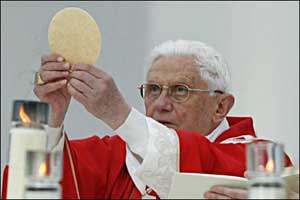
Pope Benedict
adores the unleavened bread host.
|
TRANSUBSTANTIATION
teaches that the round unleavened host is really truly and substantially
the body and blood of Christ and must be worshipped as God.
The host
is placed in a monstrance for perpetual adoration.
|

Host
in the monstrance for perpetual adoration.
|
According
to the Canons and Decrees of the Council of Trent, anybody who does
not believe in transubstantiation is a heretic and dammed to hell:
CANON
I.-If any one denieth, that, in the sacrament of the most holy Eucharist,
are contained truly, really, and substantially, the body and blood
together with the soul and divinity of our Lord Jesus Christ, and
consequently the whole Christ; but saith that He is only therein as
in a sign, or in figure, or virtue; let him be anathema. (13th Session,
Canon I ).
CANON
VI.-If any one saith, that, in the holy sacrament of the Eucharist,
Christ, the only-begotten Son of God, is not to be adored with the
worship, even external of latria; and is, consequently, neither to
be venerated with a special festive solemnity, nor to be solemnly
borne about in processions, according to the laudable and universal
rite and custom of holy church; or, is not to be proposed publicly
to the people to be adored, and that the adorers thereof are idolators;
let him be anathema. (13th Session, Canon VI).
After
the Council of Trent, hundreds of thousands of Protestant Christians
were martyred because they refused to believe in transubstantiation
and acknowledge that the DEAD BREAD was the God of the universe.
The
unleavened bread host cannot be JEHOVAH because the Scriptures emphatically
state that the Most High Elohim does not live in man-made objects:
Howbeit
the most High dwelleth not in temples made with hands; as saith the
prophet,
Heaven is my throne, and earth is my footstool: what house will ye
build me? saith the Lord: or what is the place of my rest? Hath not
my hand made all these things? (Acts 7:48-50).
The Orthodox Church
still refers to unleavened bread as dead bread!! The
Orthodox call unleavened bread DEAD BREAD!!
The
Eastern Orthodox Church continues the ancient practice of using leavened
bread in the Eucharist. Thus, the sacramental bread symbolizes the Resurrected
Christ. The sacramental bread, known as prospora, may be made
out of only four ingredients:
|
the
finest (white) wheat flour |
|
pure
water |
|
yeast
|
|
salt
|
|
|
They refer to
unleavened bread as DEAD BREAD:
For
the body without breath is dead. And matzo only—which does not
have leaven—is dead, and not a living loaf. For the leaven gives
life and oneness to the dough, just as the spirit does to the body
and salt to the mind. And due to this we celebrate the sacrament through
the perfect loaf. In accordance with this, the four evangelists say
that in the holy mysteries the Lord handed over a perfect loaf—and
not matzo—so that they might believe him to have a perfect body
from the holy virgin. Now by perfect I mean one that was with soul
and mind, and not—as the heretic Apollinaris said—that
he took only a body. (Mahlon, And Taking Bread: Cerularius and
the Azyme Controversy of 1054, p. 137).
The
controversy between leavened and unleavened bread raged for centuries.
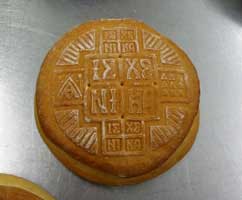
Leavened
Orthodox communion bread called a prosphoron.
|
The Orthodox
refer to unleavened bread as DEAD BREAD!!
Nothing
magical happens during their communion and the host is not worshipped
as God.
|
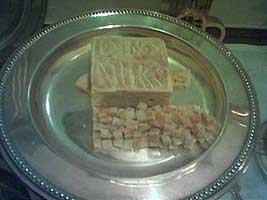
Orthodox
leavened bread for the members of the congregation.
|
Chronology
of the last 3 days in the life of Joshua
The last 3 days
of the earthly life of Joshua were momentous days in the history of
Israel. Joshua came to abolish the Old Covenant by fulfilling it and
replacing it with the New Covenant. The Temple rituals with the animal
sacrifices, Aaronic priesthood, and circumcision were all abolished
forever.
The Passover celebration
was changed into the Lord's Supper and the time of the celebration was
moved one day backward.
The Sabbath was
also changed from the 7th day to the First day of the Jewish week in
commemoration of the Resurrection.
JEHOVAH alone has
power to change the times and seasons:
And he changeth
the times and the seasons. (Daniel 2:21).
The
Jewish days overlap our days because their days began in the evening.
Tuesday/Wednesday
Nisan 14.
| Time
|
Event |
| 6
p.m. |
Joshua
meets in the upper room with his disciples. Institution of the
Last Supper. He washes the disciples' feet and has a leisurely
supper of bread and wine with his disciples. Gives final instructions
to the disciples. |
| 12
p.m. |
Joshua is arrested in the Garden of Gethsemane on the Mount of Olives. |
| 6
a.m. |
Joshua's
trial before Pilate begins. |
| 10
a.m. |
Joshua
is nailed to a tree on the Mount of Olives overlooking the Temple.
|
| 12
p.m. |
Darkness
over the whole land until 3 p.m. |
| 3
p.m. |
Joshua
dies on the tree and goes to Paradise with the repentant thief.
Passover lambs are killed in the Temple. |
| 6
p.m. |
Joshua
is buried in the tomb of Joseph of Arimathea on the Mount of Olives.
Jewish Passover begins. |
Wednesday/Thursday
Nisan 15
Time
|
Event |
6
p.m. |
Passover
meal eaten hastily with roast lamb, unleavened bread, and bitter
herbs. |
| 6 a.m. |
No
work was allowed on this day as it was the Day of Preparation
also called a High Day or the Passover Sabbath. |
| 6 p.m. |
Passover Sabbath
ends. Joshua
is now
in the tomb 24 hours. |
Thursday/Friday
Nisan 16
Time
|
Event |
6
p.m. |
This
is the beginning of the day after the Passover Sabbath. |
| 6 a.m. |
This
is an ordinary working day. Pharisees go to Pilate for a guard
to watch His tomb in case the disciples steal his body and fake
a resurrection!! |
| 9 a.m. |
Women disciples
buy sweet spices to embalm the body of Joshua
. They
find the tomb guarded by soldiers so they have to wait. |
| 6 p.m. |
Weekly Jewish
Sabbath begins. Joshua
is now
in the tomb 48 hours. Weekly Jewish Sabbath begins. |
Friday/Saturday
Nisan 17
Time
|
Event |
6
p.m. |
Beginning
of the weekly Jewish Sabbath. |
6
a.m. |
No
work is allowed on this day because it is the regular weekly Sabbath.
|
| 6 p.m. |
End
of the weekly Jewish Sabbath. Joshua
is now
in the tomb 3 days and 3 nights for a total of 72 hours. |
Saturday/Sunday
Nisan 18
Time
|
Event |
6
p.m. |
End
of the weekly Jewish Sabbath. Beginning of the first day of the
Jewish week. |
3.
a.m. |
A
great earthquake occurs as an angel of the Lord descends from
Heaven and rolls back the stone to the sepulcher on the Mount
of Olives. The soldiers are paralyzed with fear, and when they
recover, they report the incident to the chief priests who offer
them money to say that the disciples stole the body while they
slept!! |
| 6 a.m. |
Miriam Magdalene
visits the tomb and finds the stone rolled away and an angel announces
that Joshua
is risen.
|
| 7 p.m. |
Peter
and John run to the tomb and find that it is empty. |
| 9 p.m. |
Joshua
walks
with two disciples on the road to Emmaus, and after proving that
He is alive, vanishes out of their sight. |
| 6 p.m. |
Joshua
appears
to the doubting frightened disciples and assures them that He is
indeed alive. |
Obviously, according
to this Scriptural chronology, GOOD FRIDAY is a MYTH...That
there were 2 Sabbaths that week is proven by this verse:
In
the end of the sabbaths, as it began to dawn toward the first of the
sabbaths, came MIriam Magdalene and the other Miriam to see the sepulchre.
(Matthew 28:1).
What this verse
is teaching is that the old Jewish Sabbath was completely fulfilled
when Joshua rested for 3 days and 3 nights in the tomb. The new Sabbaths
are the Resurrection Sabbaths or the Lord's day.
References
Emminghaus,
Rev. Johannes H. The Eucharist: Essence, Form, Celebration.
The Liturgical Press. Collegeville, Minnesota. 1978.
George
Galavaris. Bread and the Liturgy. The Symbolism of Early Christian
and Byzantine Bread Stamps. University of Wisconsin Press, Madison,
1970.
Jungmann,
Rev. Joseph A. The Mass of the Roman Rite: Its Origin and Development.
(In 2 Volumes). Christian Classics, Allen, Texas, 1986.
Smith,
Mahlon H. And Taking Bread: Cerularius and the Azyme Controversy
of 1054. Théologie Historique, Éditions Beauchesne,
Paris, 1978.
Copyright
© 2013 by Patrick Scrivener
Back
to Deadly Errors of the Latins |









